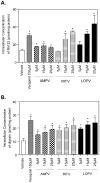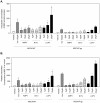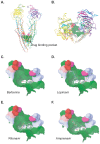Inhibition of P-glycoprotein by HIV protease inhibitors increases intracellular accumulation of berberine in murine and human macrophages
- PMID: 23372711
- PMCID: PMC3553168
- DOI: 10.1371/journal.pone.0054349
Inhibition of P-glycoprotein by HIV protease inhibitors increases intracellular accumulation of berberine in murine and human macrophages
Abstract
Background: HIV protease inhibitor (PI)-induced inflammatory response in macrophages is a major risk factor for cardiovascular diseases. We have previously reported that berberine (BBR), a traditional herbal medicine, prevents HIV PI-induced inflammatory response through inhibiting endoplasmic reticulum (ER) stress in macrophages. We also found that HIV PIs significantly increased the intracellular concentrations of BBR in macrophages. However, the underlying mechanisms of HIV PI-induced BBR accumulation are unknown. This study examined the role of P-glycoprotein (P-gp) in HIV PI-mediated accumulation of BBR in macrophages.
Methodology and principal findings: Cultured mouse RAW264.7 macrophages, human THP-1-derived macrophages, Wild type MDCK (MDCK/WT) and human P-gp transfected (MDCK/P-gp) cells were used in this study. The intracellular concentration of BBR was determined by HPLC. The activity of P-gp was assessed by measuring digoxin and rhodamine 123 (Rh123) efflux. The interaction between P-gp and BBR or HIV PIs was predicated by Glide docking using Schrodinger program. The results indicate that P-gp contributed to the efflux of BBR in macrophages. HIV PIs significantly increased BBR concentrations in macrophages; however, BBR did not alter cellular HIV PI concentrations. Although HIV PIs did not affect P-gp expression, P-gp transport activities were significantly inhibited in HIV PI-treated macrophages. Furthermore, the molecular docking study suggests that both HIV PIs and BBR fit the binding pocket of P-gp, and HIV PIs may compete with BBR to bind P-gp.
Conclusion and significance: HIV PIs increase the concentration of BBR by modulating the transport activity of P-gp in macrophages. Understanding the cellular mechanisms of potential drug-drug interactions is critical prior to applying successful combinational therapy in the clinic.
Conflict of interest statement
Figures






References
-
- Zhou H, Pandak WM Jr, Lyall V, Natarajan R, Hylemon PB (2005) HIV protease inhibitors activate the unfolded protein response in macrophages: implication for atherosclerosis and cardiovascular disease. Mol Pharmacol 68: 690–700. - PubMed
-
- Zhou H, Jarujaron S, Gurley EC, Chen L, Ding H, et al. (2007) HIV protease inhibitors increase TNF-alpha and IL-6 expression in macrophages: involvement of the RNA-binding protein HuR. Atherosclerosis 195: e134–143. - PubMed
-
- Parker RA, Flint OP, Mulvey R, Elosua C, Wang F, et al. (2005) Endoplasmic reticulum stress links dyslipidemia to inhibition of proteasome activity and glucose transport by HIV protease inhibitors Author. Mol Pharmacol 67: 1909–1919. - PubMed
Publication types
MeSH terms
Substances
Grants and funding
LinkOut - more resources
Full Text Sources
Other Literature Sources
Research Materials
Miscellaneous

